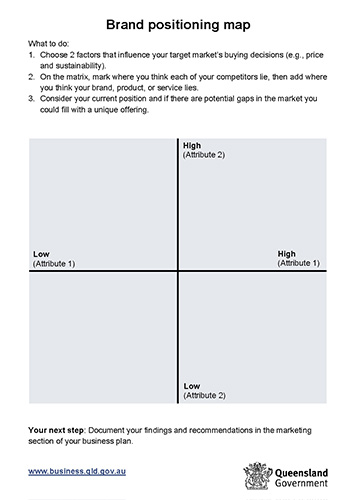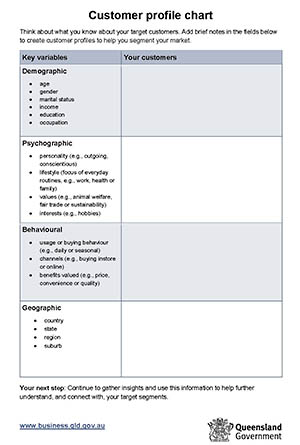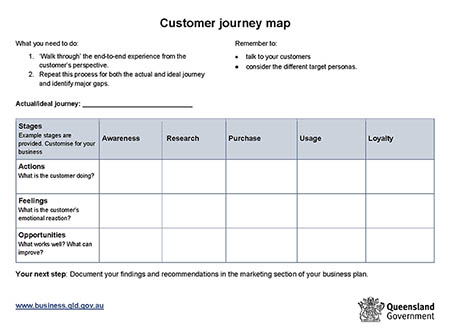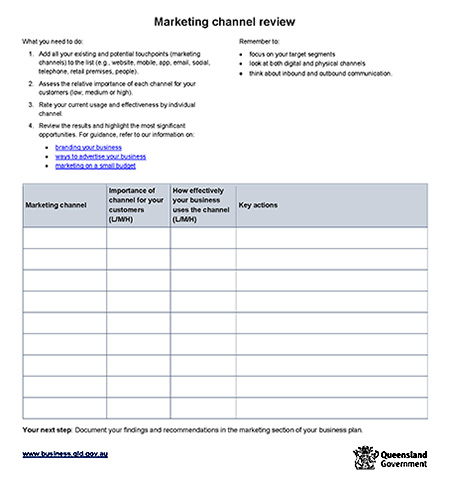Becoming a customer-focused business
By better identifying and understanding your customers, you can create exceptional products and services that keep them coming back. You'll also be able to effectively market your business across every stage of the customer lifecycle.
Why you have to focus on the customer
Most businesses know they need loyal and profitable customers to survive and thrive. Delivering a positive customer experience is a great competitive advantage.
Being customer-centric will help your business to:
- grow your revenue by selling more to your existing customers and attracting new customers
- increase customer satisfaction, thereby creating happier customers who talk about and recommend your business
- lower your operational costs – for example, by enabling customers to serve themselves on your website, instead of calling your business
- improve employee engagement – for example, frontline staff are motivated and enabled to listen and respond to customers.
Customers now have more control over what, where and how they buy than ever before. They:
- have better access to information
- have more products, services and providers to choose from
- can share reviews, thoughts and opinions.
Customer experience is an important differentiation between brands. Customers want brand experiences that are:
- fast – they want to do get things done quickly and easily
- transparent – they expect businesses to be honest, credible and trustworthy
- personalised – they want an experience that is relevant to them and not intrusive or pushy
- frictionless – they expect seamless interactions across digital and physical channels
- delightful – they want experiences that are enjoyable and that deliver memorable moments.
Make sure this forms part of your approach to building your business brand.
Action item: 8 ways to be more customer focused
- Talk to existing customers to find out why they like doing business with you and where you can improve.
- Read online reviews of your business. Can you make any changes to improve customer satisfaction?
- Ask a friend to contact your business with an enquiry and ask them for honest feedback about their experience.
- Ensure all your inbound channels (e.g. telephone, email and social media) respond quickly and professionally to customer queries.
- Encourage your staff to personally thank customers for their business – this could include a follow up email.
- Contact your customers after a major purchase to check if they're happy and ask for feedback.
- Check that your initiatives (e.g. sales promotions) reward new and existing customers – don't upset loyal customers.
- Find the right balance between sticking to business policies and procedures and being flexible through, for example, special orders and extended opening hours.
Assess your current situation
Think about your business and honestly answer these questions:
- Do you claim to be focused on the customer? For example, do your marketing messages and website say that customer service is very important to you?
- Do you behave in a customer-oriented way? Are your actions (e.g. your processes and procedures) guided by your customers.
Most business will answer yes to question 1. If you can also confidently answer yes to question 2, your business has the right foundations to be customer first.
Find areas to improve
- Use our interactive customer-focus quiz to identify opportunities for improvement.
- Complete the interactive marketing health check to find out how to further improve your marketing.
- Consider completing a SWOT analysis to understand your business's strengths, weaknesses and opportunities.
Segmentation, targeting and positioning (STP)
Segmentation, targeting and positioning (STP) involves dividing a big group (the broad market) into smaller groups called segments. Each segment must have clearly different identifying characteristics.
To do this, you have to do research and analysis, including:
- interviews
- online surveys
- reviewing customer data (like sales) and digital information.
Advantages of STP
Unlike a 'one size fits all' marketing approach, STP can help your business to:
- identify new market opportunities
- get to know your customers and their needs
- focus your resources on the most important segments
- work out how to best reach your customers
- deliver relevant and personalised messages
- increase sales.
STP in 3 steps
-
Decide how you want to divide your market. Think about what factors are most relevant to your market and your business.
As a starting point, consider the 4 most popular types of segmentation, discussed below:
- demographic
- psychographic
- behavioural
- geographic.
Once you've decided on the best approach and have gathered all the information you need, you can segment the market.
Demographic
Demographic segmentation is about deciding who your main target audience is. It's a straightforward and useful approach. You can define your segment using any combination of basic characteristics, such as:
- age
- gender
- marital status
- income
- education
- occupation
- business.
You can find information about these categories quite easily by, for example, looking at census data.
If you market to other businesses, you can include factors like industry and company size.
Example: A software provider may focus on IT professionals who work in medium-sized businesses with 20–199 employees.
Psychographic
Psychographic segmentation is often combined with demographic segmentation. It's based on psychological and personality traits and social and emotional factors like:
- lifestyle
- attitudes
- values
- opinions
- interests.
Example: A personal training business focuses on women who value health and fitness and enjoy outdoor adventure.
Behavioural
Behavioural segmentation divides customers according to their spending and buying habits and how they interact with your business. This may include:
- how they decide what to buy (e.g. is price, convenience, or brand most important to them?)
- which channels they use (e.g. do they shop instore, on online)
- when and how often they buy from you (e.g. regularly, or only seasonal or on special occasions?).
Example: An electronics business focuses on customers who prefer to place orders on the website and who value same-day delivery.
If you're doing business online, find out how to research your audience and segment your market based on their online behaviour.
Geographic
As the name suggests, geographic segmentation is based on location. Depending on the business type, this could be a:
- country
- state
- region
- postcode
- suburb.
Example: A restaurant in a shopping centre focuses on existing and potential customers who live or work within 5km.
-
To target your ideal customers, you should be confident that there are clear and meaningful differences between the market segments.
You can then choose your high priority target segments by comparing them based on what's most important to your business. For example:
- size – is a segment large enough and does it have potential to grow in the future?
- profitability – can the segment deliver enough financial value?
- accessibility – can you reach and engage the target segment?
- stability – will it stay relatively stable over time?
Include these decisions in your marketing plan.
-
Now that you've identified your most valuable customers:
- review your value proposition and develop unique selling points that emphasise key benefits for your target audience
- design a unique marketing mix for each target segment that will be most effective.
Brand positioning map
To help visualise your market, you can draft a positioning map. An online search will provide plenty of examples. Download our brand positioning template and follow these simple steps:
- Choose 2 attributes that influence purchase (e.g. value and service).
- On the matrix, plot the position of your brand and major competitors.
- Think about your current position and potential gaps in the market.
Customer profile chart
Answering the questions in our customer profile chart will help to:
- segment your market
- understand your customers
- target your marketing activities.
Download and complete the customer profile chart to fill out and save for future reference.
You can also use our interactive customer profile chart.
Creating target personas
You can create target personas for each of your target segments. Giving your target segments a human face can help you and your staff to better understand the segments.
Do an online search for examples of customer personas and templates for creating personas. You can then develop individual profiles which typically include:
- a description of the character
- their needs and preferences
- their attitudes and behaviours
- the challenges and opportunities they represent.
Continue to review and refine your target personas. The more you learn about your customers, the better your personas will be. The better your personas are, the more targeted and effective your marketing programs will be.
If you do a lot of marketing or business online, find out how you can build digital customer personas.
Mapping the customer journey
Customer journey mapping looks at every step of the customer experience from the customer's point of view. It will help you:
- understand important interactions from your customer's perspective
- ensure your customers' actual experiences match the ideal customer experience
- decide where to focus your efforts based on solid insights, rather than guess work.
To make this work well, you'll need information about your business and your customers. Find out more about doing customer research and market research.
How to map customer journeys
- Write down the end-to-end steps of the theoretical customer journey for your industry and business type.
- Using your target personas and customer feedback, work through the actual journey your customers are taking currently.
- Look at your customer needs and feedback and design the ideal journey to meet those needs.
- Identify the biggest gaps between the actual and ideal journey.
- Prioritise short, medium and long-term improvements to address these gaps.
Customer journey mapping template
Download, customise and complete our customer journey mapping template to help you make the most of your marketing efforts with every customer touchpoint.
Tips for journey mapping
- Choose goals that match the available skills, time and money in your business.
- Document exactly how you plan to make the improvements.
- Look for quick wins that can make a positive difference.
- Also look at other industry and areas for improvement opportunities.
Customer lifecycle marketing
Customer lifecycle marketing is an advanced marketing approach that can help you further personalise your communications within your target segments.
Customer lifecycle marketing is about:
- focusing on the lifetime value of your customers, not just transactional sales. This is particularly important if you run a business that thrives on long-term relationships
- supporting customers during every stage of their interaction with your business – as they research, choose, buy, use and endorse your products and services
- communicating with customers in a personalised and cohesive way across many channels.
This can help you to:
- make your communication more relevant and effective
- attract your ideal customers
- increase sales
- improve the customer experience.
Lifecycle marketing in 4 steps
Whether your target segments are business-to-consumer (B2C) or business-to-business (B2B), lifecycle marketing is about turning insights into action.
-
Identify the customer lifecycle stages that make the most sense for your business by mapping the customer journey.
These could be, for example:
- awareness – your message has reached a potential customer
- interest – the potential customer shows interest by, for example, visiting your digital channels
- conversion – the potential customer buys your products or services
- action – what happens immediately after the conversion (e.g. to make your customer feel positive about the interaction)
- retention – maintaining a connection with your customer to support future purchases and encourage positive word-of-mouth referrals.
-
Think about how you can use the marketing mix across the customer lifecycle.
You could, for example, look at using:
- conversion funnels
- direct marketing
- digital marketing
- automated marketing technology.
Remember to:
- choose initiatives that will support your marketing objectives
- include customer lifecycle marketing when you write your marketing plan.
-
To shift towards customer lifecycle marketing rather than standalone campaigns, you might need to make some changes. Make sure you think about your:
- internal team – do you and your staff have the necessary information, skills and time?
- external partners – would you be able to use existing partners, or do you need to look for new partners?
- customer service – do you have the right service program and principles?
- processes and procedures – do you need to improve or change any of your business processes?
-
Remember, you don't have to do it all. You can start by looking for easy wins.
For example, if you run a subscription business, you could use email marketing to send a personalised message when a customer signs up.
Marketing channel review template
Use this template to find opportunities to:
- choose the marketing channels that are best suited for your target audience
- improve the effectiveness of your chosen marketing channels.
Download and complete the template for reviewing your marketing channels.
Using marketing technology
Marketing technology will continue to become more advanced and more accessible. Depending on your business needs and internal expertise, you may be able to take advantage of tools like:
These tools can:
- make your customer lifecycle marketing more automated and coordinated
- deliver better reporting and information on your customers.
You could:
- set up an automated reaction that is triggered by certain a specific customer action or event (e.g. a birthday)
- improve your future marketing by tracking how well certain initiatives performed for each target segment.
Find out more about choosing suppliers for your business.
Check your progress
If you can comfortably tick off these 5 items, you'll be well on your way to get the benefits of being a customer-centric business:
- We have clearly defined and known target segments.
- We regularly review and act on customer feedback.
- We consider the customer when we make decisions.
- We actively manage and improve the customer experience.
- We plan and deliver personalised communications.
As you continue to learn more about your customers, remember to update your marketing plan.
Also consider...
- Learn how to advertise your business.
- Find information on writing a marketing strategy and plan.
- Learn about managing public relations and the media.
- Explore marketing on a small budget.
- Read about networking in business.
- Learn about the benefits of being a bike-friendly business.



